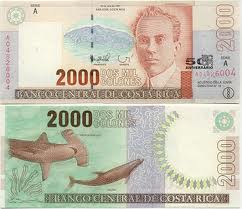Currency & Credit Cards:
The local currency is the Colon, plural Colones. As of July 1, 2015, the exchange rate was about 534 Colones to the U.S. dollar. Generally speaking, goods in local stores such as a grocery, pharmacy, or souvenir shop will be priced in Colones. Some souvenir shops may price goods in dollars. Hotel rates and condo rental rates will usually be quoted in dollars as will rent-a-car rates. Real estate prices are always in U.S. dollars. For quick estimates, at the current exchange rate (just above 500 C/$), to convert a price stated in Colones, say a meal in a restaurant, to dollars, move the decimal three places to the left, and multiply by two. For example, an entrée priced at 5,000 C would be (5 X 2) or about $10.00. The clerks in local stores will have no trouble converting for you and will not take advantage of you. If you hand a clerk in a grocery store a $10 bill, he or she will use either a calculator or the cash register to calculate your change. Usually you will be given change in Colones. Coins will be 5, 10, 20, 25, 50, 100, 200, and 500 Colones while bills will be 1,000, 2,000, 5,000, and 10,000. You won’t see notes larger than 10,000 Colones, roughly the same as a $20.00 bill. There is no need to exchange money for your trip. Just use your U.S. currency although it would be wise to avoid $50 and $100 bills.
Likewise, traveler’s checks will be more trouble than they’re worth. You will wait in line to cash them in a bank and then pay an official exchange rate. The same is true at a hotel desk. You’re much better off just spending U.S. dollars. In addition, credit cards are widely accepted with the exception of a few restaurants. Visa and MasterCard will be the easiest to use. American Express will be fine at hotels, rent-a-car companies and the like but will be less frequently accepted at small shops and at restaurants. ATM’s are easy to find and as soon as the machine recognizes that your card is U.S. based it will generally offer instructions in your choice of Spanish or English and will dispense your choice of either dollars or Colones. Using the ATM is far easier than using traveler’s checks.
Any restaurant check will include a 10% tip and a 13% tax. The prices of items on a menu may or may not include these items but the menu will say somewhere whether or not they are included. Many menus will show the prices both ways. Since they don’t use or accept U.S. coin in Costa Rica you may end up paying a bit more in some restaurants if you pay in U.S. currency since they might just round up to the nearest dollar rather than provide change. Usually however they will just give you the change in Colones. Additional tips are welcome of course but not necessary. As with travel anywhere, tips are appropriate for taxi drivers, tour guides, airport valets, etc. but the wage scale in Costa Rica is much lower than in the U.S. so you needn’t tip as much as you would in the U.S. for such services.
Tele-Communications:
Your cell phone may or may not work in Costa Rica. They have a modern telecommunications infrastructure and cell coverage is generally good. Check with your provider to see if you will have service there and what it will cost to make calls.
It will generally be much less expensive to use one or two other means to stay in touch with home. If you travel with a computer, iPhone, iTouch, iPad, etc., then email, the “messaging” application, and Skype will provide cheap or free communications. Many restaurants, particularly in the tourist areas, hotel lobbies, condominiums, and so forth offer free wi-fi. Our condo has a free open broadband connection as does the condo pool, the hotel lobby, the beach club, and most of the restaurants in the area.
If it is important for people to be able to reach you and email isn’t sufficient, consider buying a Skype-in number which will allow someone at home, say in the U.S., to call a local number where you live and reach you on your mobile device at very low cost.
If you don’t want to travel with an intelligent mobile device there is another inexpensive and easy alternative. Every little mercado (markets about the size of a U.S. convenience store but with a wider variety of merchandise) can sell you an I.C.E card. I.C.E (pronounced “EE-Say”) are the initials of the Costa Rican national electric utility which also operates the phone system. The card will cost $10 or less and will give you plenty of cheap minutes. You just call a local number listed on the back of the card from any local phone or pay phone, key in the card number, and then dial your international destination. In our condo for example, we have a phone that allows calls to numbers in Costa Rica but we have it blocked to prevent international calls since we would have no means to recover that cost. So you could use the I.C.E card from our condo phone, the phone in your hotel room and so on.
Electricity:
Costa Rica uses the same 110/120V electrical system that is used in the U.S. and Canada. The electrical outlets are the same. If you are visiting from the U.S. or Canada all of your electric devices will plug in and work without any problems in Costa Rica. If you are visiting from other countries with different voltage standards and outlets you will need converters for 110/120V.

